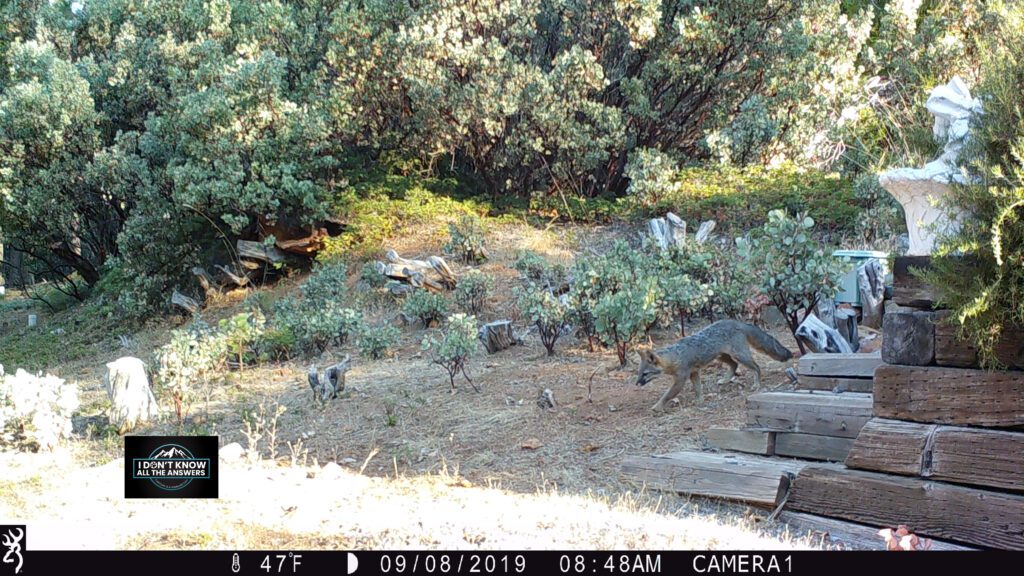In Arnold, I became very familiar with gray foxes. We had a small gray fox family living on the property. I thoroughly enjoyed observing these beautiful animals up close. Surprisingly, when I set up my field cameras in our new backyard in Tracy, I also found evidence of gray foxes here through the photographs. The unexpected discovery of these elusive creatures thriving in a completely different environment was a delightful surprise! It was a moment that rekindled my love for wildlife and brought a new level of excitement to my Tracy backyard.


Habitat and Range
With their remarkable adaptability, gray foxes range from southern Canada to northern Venezuela and Colombia. They thrive in various habitats, primarily dense vegetation like forests and woodlands, deserts, chaparral, and agricultural lands. This adaptability is a testament to their resilience. It makes their presence in Tracy, primarily agricultural land, all the more impressive.
Have you ever heard of a fox that can climb trees? Meet the gray fox, one of the few canids* with this incredible ability. Beyond just tree-climbing, gray foxes are fascinating creatures with unique characteristics that set them apart from their well-known red fox cousins. Their distinctiveness, from their tree-climbing ability to their nocturnal hunting behavior, is sure to captivate any wildlife enthusiast.
*Note: Canid’s definition per the Merriam-Webster dictionary is “any of the family (candidae) of carnivorous animals that includes the wolves, jackals, foxes, coyotes, and the domestic dog.”
Behavior and Diet
Gray foxes are not picky eaters and will adapt their diet based on what is available in their habitat. Gray foxes are primarily nocturnal solitary hunters, preferring to hunt under the cover of darkness. Their varied and opportunistic diet includes small mammals like rodents and rabbits, birds, insects, fruits, and carrion. This diet adaptability is one reason they can thrive in a wide range of environments.
Adaptations
One of the most intriguing adaptations of the gray fox is its ability to climb trees. They are relatively small, weighing between 7 and 11 pounds (3 and 5 kg) and measuring around 32 to 45 inches (81 to 115 cm) in length, including their tail. Gray foxes have shorter legs and smaller feet, making them well-adapted for climbing trees. This unique ability allows them to escape predators or find food in hard-to-reach places. Thanks to their semi-retractable claws, they can ascend trunks to escape predators or forage for food. Their fur, a beautiful mix of gray, black, white, and rust, provides excellent camouflage, allowing them to blend seamlessly into their surroundings, whether in a forest or a desert landscape. Additionally, gray foxes are known for their agility and speed, capable of reaching up to 28 miles per hour (45 km/h).
Social Structure
Unlike many other canids that live in large packs, gray foxes tend to establish small family groups. Their solitary nature means that sightings can be rare, adding to their mysterious charm.
Conservation Status
Currently, gray foxes are not considered endangered. However, like many wildlife species, they face threats from habitat loss and human encroachment. Efforts to conserve their habitats are crucial to ensure their populations remain stable.
If you’re as captivated by these creatures as I am, consider learning more about conservation initiatives to protect gray foxes and their habitats. These initiatives are not just crucial, they are our responsibility. Whether it’s supporting local wildlife reserves, participating in habitat restoration projects, or advocating for responsible land development, your contribution can make a significant difference in ensuring the survival of the enigmatic gray fox for future generations.
References:
What Do Squirrels Eat? | All About Squirrels. https://www.allaboutsquirrels.org/what-do-squirrels-eat/
Are there different kind of foxes?. https://www.colorwithleo.com/are-there-different-kind-of-foxes/
10 Reasons Why Flying Fish Are Key To Marine Ecosystems. https://aquaticoceans.com/10-reasons-why-flying-fish-are-key-to-marine-ecosystems/
Thank you for reading this blog post. If you have any questions or comments, please leave them in the Comments section below.
Copyright © 2019. I Don’t Know All The Answers, Nikki Mastro.
All of my photographs and documents are Copyrighted.
The main photo included in this blog post is from the iStock.com library.
No part of this website, including text, photographs, and documents, may be reproduced, stored in a retrieval system, or transmitted in any form or by any means without written permission from the copyright holder. All unauthorized use is strictly prohibited. If you choose to copy or share any information from my site, you must provide a link to the source. I appreciate your cooperation.
For further information concerning “I Don’t Know All The Answers.”
– Website and Blog: https://www.idontknowalltheanswers.com
– Facebook: https://www.facebook.com/Nikki.L.Mastro/
– Instagram: https://www.instagram.com/i_dont_know_all_the_answers/
– Linkedin: https://www.linkedin.com/in/nikki-mastro-05455a3a/
– Youtube Channel: https://www.youtube.com/@idontknowalltheanswers1954


Beautiful!